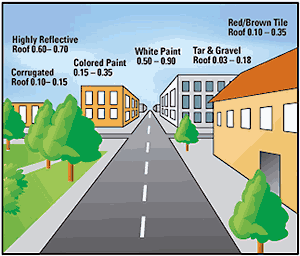 Albedo of Roofs
Albedo of Roofs
Warm weather seems to finally be on its way here, after a particularly long winter this year. Personally I’d rather be hot than cold, but it’s true that I’ve never experienced a summer like a DC summer before last year. If you’ve ever visited the National Capital in the summertime, you probably know what I’m talking about – the humidity is so high and the air so still that it sometimes feels like you’re walking around in a boiler, even in the early morning hours. D.C.’s high humidity can make summer here slightly unbearable, but in fact many other cities in the U.S. get hotter.
Highly populated areas suffer more than their rural neighbors due to a phenomenon called the urban heat island effect. Ambient air temperatures of cities can be 22° higher in the summer than surrounding areas! This is because the concrete, asphalt, and roofing materials get superheated by the sun, radiating all that heat right back onto us, and the density of buildings traps warm air close to the surface. Imagine the increased energy costs of trying to cool your house in that environment!
Therefore, many cities are implementing building standards that mandate installation of white roofs where appropriate. Homeowners would be wise to consider a white roof when theirs next needs replacing, regardless of whether they are urbanites or rural folks.
According to Dr. Arthur Rosenfeld of the International Energy Agency (IEA), white roofs are usually 5°-10° higher than the ambient temperature, whereas a traditional dark roof runs 40°-50° hotter! The science behind this is simple – white roofs reflect energy while dark roofs absorb. The benefits of white roofs are three-fold
1. Reduced energy costs to the homeowner. A hot roof means that the air below that roof is warmer too, which means you spend more money trying to cool it down by running your air conditioner. White roofs are so significantly cooler that the air in your home will hardly be heated at all, meaning your energy bill in the summer could take a major cut.
2. Reduced Urban Heat Island Effect. If city roofs are white, they are going to reflect a lot of the solar energy back into space before it gets a chance to heat the sidewalks and streets below, bringing relief to city dwellers. The urban heat island effect can be very dangerous; heat waves, which are more common in our changing climate, claim many lives every summer. Cities have become very interested in alleviating this effect for public health reasons.
3. Cools the climate. “…converting most flat roofs in warm cities to white would cancel warming from more than one gigatonne of CO2 per year for the average lifetime of the roofs. In terms of emissions, it’s equivalent to taking half the world’s cars off the road for 20 years,” says Dr. Rosenfeld. White surfaces enhance what climate scientists call the albedo effect, which is to say the reflectivity of Earth’s surfaces. Polar ice caps are major factors in the Earth’s albedo effect, diverting much of the solar energy that hits the planet back into space before it can be trapped by the greenhouse effect, thus keeping our planet from getting too hot.
And don’t think that you’re excluded from the white roof movement if you have solar panels on your roof! Solar panels lose efficiency when they get too hot, but some studies have suggested that white roofs can actually increase the efficiency of solar panels by preventing the roof from heating beyond the optimal temperature range for solar panels.
If you have a flat roof, you can paint it yourself, or you can contract a company to do install a colored roof with a high solar reflectance for a slanted roof.
It’s a fantastic opportunity when we can make ourselves more comfortable in our homes, save ourselves money, and do something good for the planet. Below are some helpful links for anyone considering a white roof.
Check out Database of State Incentives for Renewables & Efficiency (DSIRE) for any rebates offered in your state for installing a cool roof.
The EPA offers an online calculator to help you estimate your savings by installing a cool roof: http://roofcalc.com
For the die-hard researcher, the Dept. of Energy has published these Guidelines for Selecting Cool Roofs.
Tags
Subscribe to NV Roofing's Blog



